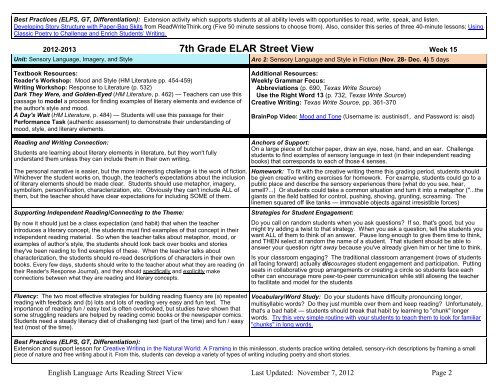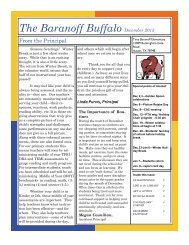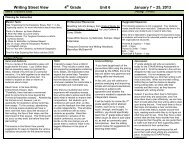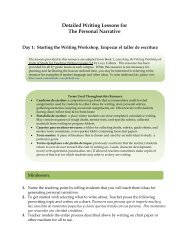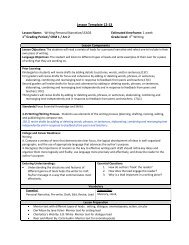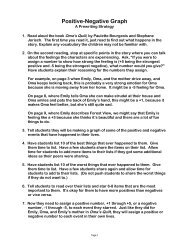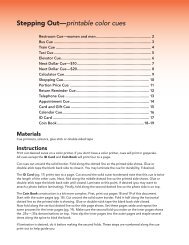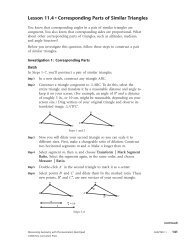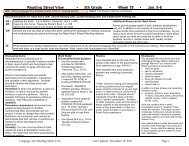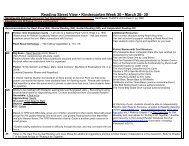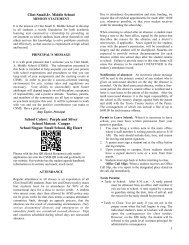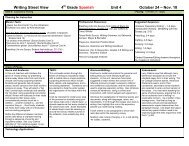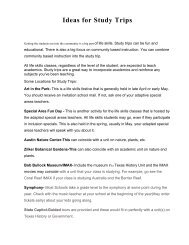7th Grade ELAR Street View
7th Grade ELAR Street View
7th Grade ELAR Street View
Create successful ePaper yourself
Turn your PDF publications into a flip-book with our unique Google optimized e-Paper software.
Best Practices (ELPS, GT, Differentiation): Extension activity which supports students at all ability levels with opportunities to read, write, speak, and listen.Developing Story Structure with Paper-Bag Skits from ReadWriteThink.org (Five 50 minute sessions to choose from). Also, consider this series of three 40-minute lessons; UsingClassic Poetry to Challenge and Enrich Students’ Writing.2012-2013 <strong>7th</strong> <strong>Grade</strong> <strong>ELAR</strong> <strong>Street</strong> <strong>View</strong> Week 15Unit: Sensory Language, Imagery, and StyleArc 2: Sensory Language and Style in Fiction (Nov. 28- Dec. 4) 5 daysTextbook Resources:Reader's Workshop: Mood and Style (HM Literature pp. 454-459)Writing Workshop: Response to Literature (p. 532)Dark They Were, and Golden-Eyed (HM Literature, p. 462) — Teachers can use thispassage to model a process for finding examples of literary elements and evidence ofthe author's style and mood.A Day's Wait (HM Literature, p. 484) — Students will use this passage for theirPerformance Task (authentic assessment) to demonstrate their understanding ofmood, style, and literary elements.Reading and Writing Connection:Students are learning about literary elements in literature, but they won't fullyunderstand them unless they can include them in their own writing.The personal narrative is easier, but the more interesting challenge is the work of fiction.Whichever the student works on, though, the teacher's expectations about the inclusionof literary elements should be made clear. Students should use metaphor, imagery,symbolism, personification, characterization, etc. Obviously they can't include ALL ofthem, but the teacher should have clear expectations for including SOME of them.Supporting Independent Reading/Connecting to the Theme:By now it should just be a class expectation (and habit) that when the teacherintroduces a literary concept, the students must find examples of that concept in theirindependent reading material. So when the teacher talks about metaphor, mood, orexamples of author’s style, the students should look back over books and storiesthey've been reading to find examples of these. When the teacher talks aboutcharacterization, the students should re-read descriptions of characters in their ownbooks. Every few days, students should write to the teacher about what they are reading (intheir Reader's Response Journal), and they should specifically and explicitly makeconnections between what they are reading and literary concepts.Fluency: The two most effective strategies for building reading fluency are (a) repeatedreading with feedback and (b) lots and lots of reading very easy and fun text. Theimportance of reading fun / easy text is often overlooked, but studies have shown thatsome struggling readers are helped by reading comic books or the newspaper comics.Students need a steady literacy diet of challenging text (part of the time) and fun / easytext (most of the time).Additional Resources:Weekly Grammar Focus:Abbreviations (p. 690, Texas Write Source)Use the Right Word 13 (p. 732, Texas Write Source)Creative Writing: Texas Write Source, pp. 361-370BrainPop Video: Mood and Tone (Username is: austinisd1, and Password is: aisd)Anchors of Support:On a large piece of butcher paper, draw an eye, nose, hand, and an ear. Challengestudents to find examples of sensory language in text (in their independent readingbooks) that corresponds to each of those 4 senses.Homework: To fit with the creative writing theme this grading period, students shouldbe given creative writing exercises for homework. For example, students could go to apublic place and describe the sensory experiences there (what do you see, hear,smell?...) Or students could take a common situation and turn it into a metaphor ("...thegiants on the field battled for control, pushing, shoving, grunting, screaming. Thelinemen squared off like tanks — immovable objects against irresistible forces)Strategies for Student Engagement:Do you call on random students when you ask questions? If so, that's good, but youmight try adding a twist to that strategy. When you ask a question, tell the students youwant ALL of them to think of an answer. Pause long enough to give them time to think,and THEN select at random the name of a student. That student should be able toanswer your question right away because you've already given him or her time to think.Is your classroom engaging? The traditional classroom arrangement (rows of studentsall facing forward) actually discourages student engagement and participation. Puttingseats in collaborative group arrangements or creating a circle so students face eachother can encourage more peer-to-peer communication while still allowing the teacherto facilitate and model for the studentsVocabulary/Word Study: Do your students have difficulty pronouncing longer,multisyllabic words? Do they just mumble over them and keep reading? Unfortunately,that's a bad habit — students should break that habit by learning to "chunk" longerwords. Try this very simple routine with your students to teach them to look for familiar"chunks" in long words.Best Practices (ELPS, GT, Differentiation):Extension and support lesson for Creative Writing in the Natural World: A Framing In this minilesson, students practice writing detailed, sensory-rich descriptions by framing a smallpiece of nature and free writing about it. From this, students can develop a variety of types of writing including poetry and short stories.English Language Arts Reading <strong>Street</strong> <strong>View</strong> Last Updated: November 7, 2012 Page 2


